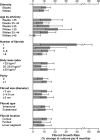Growth of uterine leiomyomata among premenopausal black and white women
- PMID: 19047643
- PMCID: PMC2604959
- DOI: 10.1073/pnas.0808188105
Growth of uterine leiomyomata among premenopausal black and white women
Abstract
Uterine leiomyomata (fibroids) are the leading cause of hysterectomy in the United States. Black women have a greater fibroid burden than whites, yet no study has systematically evaluated the growth of fibroids in blacks and whites. We prospectively tracked growth for 262 fibroids (size range: 1-13 cm in diameter) from 72 premenopausal participants (38 blacks and 34 whites). Fibroid volume was measured by computerized analysis of up to four MRI scans over 12 months. We used mixed effects models to identify factors that are associated with growth, and results were converted to percent change per 6 months for clinical relevance. The median growth rate was 9% (range: -89% to +138%). Seven percent of fibroids regressed (>20% shrinkage). Tumors from the same woman grew at different rates (within-woman component of variation was twice the component among women; both were significant, P < 0.001). Black and white women less than 35 years of age had similar fibroid growth rates. However, growth rates declined with age for whites but not for blacks (P = 0.05). The odds of a tumor growing more than 20% in 6 months also decreased with age for whites but not for blacks (P < 0.01). Growth rates were not influenced by tumor size, location, body mass index, or parity. We conclude that (i) spontaneous regression of fibroids occurs; (ii) fibroids from the same woman grow at different rates, despite a uniform hormonal milieu; (iii) fibroid size does not predict growth rate; and (iv) age-related differences in fibroid growth between blacks and whites may contribute to the higher symptom burden for black women.
Conflict of interest statement
The authors declare no conflict of interest.
Figures



References
-
- Farquhar CM, Steiner CA. Hysterectomy rates in the United States 1990–1997. Obstet Gynecol. 2002;99:229–234. - PubMed
-
- Edwards RD, et al. Committee of the Randomized Trial of Embolization versus Surgical Treatment for Fibroids. Uterine-artery embolization versus surgery for symptomatic uterine fibroids. N Engl J Med. 2007;356:360–370. - PubMed
-
- Hartmann KE, et al. Annual costs associated with diagnosis of uterine leiomyomata. Obstet Gynecol. 2006;108:930–937. - PubMed
-
- Flynn M, Jamison M, Datta S, Myers E. Health care resource use for uterine fibroid tumors in the United States. Am J Obstet Gynecol. 2006;195:955–964. - PubMed
-
- Baird DD, Dunson DB, Hill MC, Cousins D, Schectman JM. High incidence of uterine leiomyoma in black and white women: Ultrasound evidence. Am J Obstet Gynecol. 2003;88:100–107. - PubMed
Publication types
MeSH terms
Grants and funding
LinkOut - more resources
Full Text Sources
Other Literature Sources
Medical

